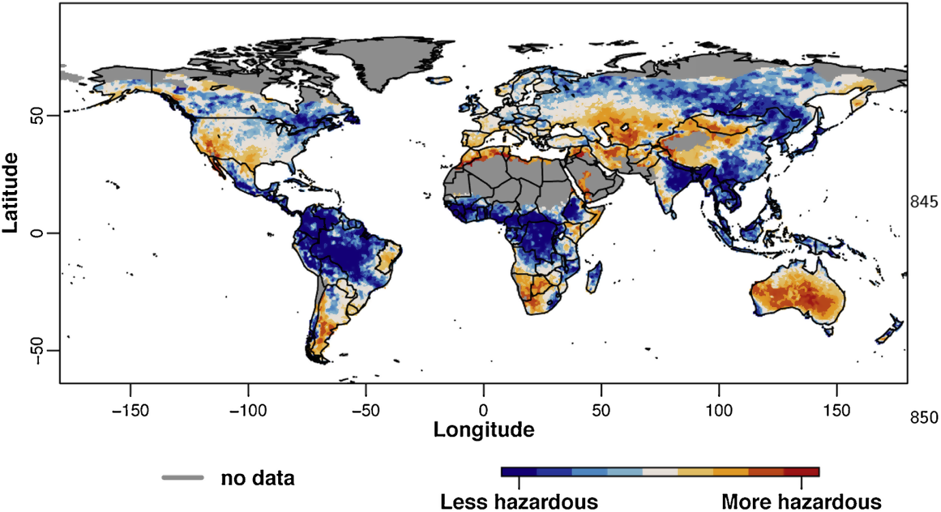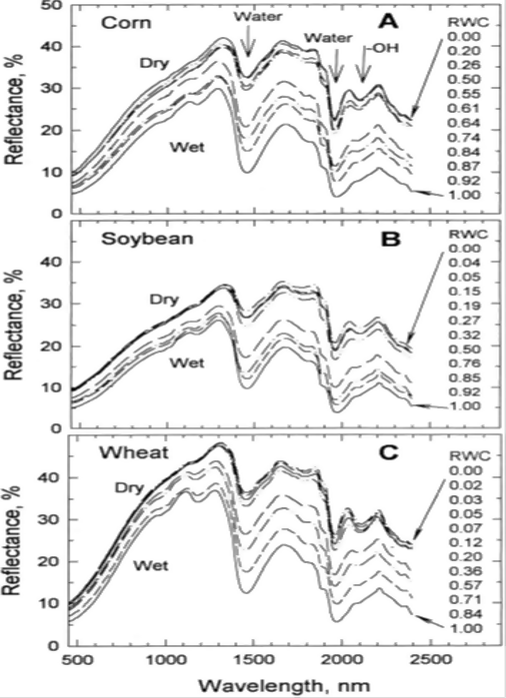October 21, 2020 at 9:43 pm | Updated March 16, 2022 at 11:26 am | 6 min read
Many parts of the world face water shortage and drought. As a result, farms and orchards are losing their capacity to produce food. According to the Food and Agriculture Organization (FAO), drought cost the world 29 billion USD in 2018; therefore, it is imperative for governments, crop consultants, and farmers to be proactive. Technology is already available for risk assessment, planning, and adapting land to drought. Among them are many small, inexpensive, and portable tools that can help make agriculture and forestry sustainable in these difficult times.
Agricultural Drought
The drought that concerns farmers and horticulturists is agricultural drought. It starts with scarce rains, which lowers the water table and decreases water in rivers and lakes. People make the situation worse by overusing and depleting groundwater reservoirs. Demand for more water comes from increasing agriculture and forestry, as well as a growing population. As a result, this further reduces the water available for growing crops.
Also, climate change makes the scarcity of water worldwide worse. Global warming is causing more extreme weather events, making rain and storms stronger in some places and droughts more frequent and severe in other places. So, semi-arid and arid regions are becoming drier. (See Fig 1 for areas that are predicted to face droughts).
Subscribe to the CID Bio-Science Weekly article series.
By submitting this form, you are consenting to receive marketing emails from: . You can revoke your consent to receive emails at any time by using the SafeUnsubscribe® link, found at the bottom of every email. Emails are serviced by Constant Contact

Figure 1: Map of areas facing drought hazard. (Image credits: Carrao et al. 2016, https://doi.org/10.1016/j.gloenvcha.2016.04.012)
According to the United Nations Convention to Combat Desertification, drought has been partly responsible for turning 12 million hectares of land barren, resulting in a loss of 20 million tons of grains.
Besides agriculture, forestry is also affected by drought. However, it is farming that bears the brunt of the drought. In developing countries, 83% of the economic losses due to water scarcity were from farms, according to FAO.
How to Adapt Farms to Drought
As experts have pointed out, relying on the current solution of using groundwater and irrigation to compensate for failing rains makes the drought worse.
It is necessary to find new ways of growing food to sustain current and future populations. Agricultural methods, which are adapted to drought and use less water, are needed since water is one of the most important factors contributing to yield. A comprehensive overhaul is needed and should include the following:
- Choosing varieties and crops that are resilient to drought. For example, growing barley instead of wheat or replacing rice with sorghum.
- Reducing the use of water by optimising irrigation. This can be achieved by
- applying water as and when necessary and in quantities necessary,
- prioritising drip and sprinkler irrigation, and
- recycling water
Optimising Irrigation
It is easier to reduce water consumption in orchards and vineyards with drip irrigation. This system is, however, not useful in close growing crops like grains. Sprinkler or surface irrigation is necessary for growing grains.
Sprinklers are useful in both farms and orchards. However, this irrigation system can be expensive, and most small farmers, especially in developing countries, cannot afford it.
Therefore, surface irrigation, the oldest form of watering, remains the most common method as it is less expensive and involves less technology, according to FAO.
Even where sprinklers and surface irrigation is used, it is still possible to optimise water use with data-driven Precision Farming. Use of new technology and analysis can minimise the impact of drought on yields and income.
Monitoring Drought
Precision farming relies on data collection of each area of a farm to find differences in conditions of water and nutrient availability. The data is analysed to find out how many inputs to apply. This can prevent overuse and ensure optimum supply. This variable rate application is the core principle of precision farming that can help drought-ridden farms.
There are large scale and small scale methods to assess drought risk to advice irrigation. The methods and tools determine the amount of water in the soil or the growth of plants to find out which areas of the farms need more water, how much of it, and when. Some of the more popular choices are covered below.
Large Scale
The most common method used to collect information on drought for a locality or region is satellite imagery. It is useful for organisations and government departments who advise farmers for future planning.
Satellite imagery taken through remote sensing shows the difference in plants’ health based on spectrometry. Different parts of the visible light range are reflected by the water content and different compounds that make up a plant tissue, so plants with more water will reflect more infrared light. Water can make up to 50 to 90% of a plant. So, spectrometry is an important means of finding out the amount of water in a plant and detecting signs of stress due to drought.

Figure 2: The difference in infrared light reflectance by corn, soybean, and wheat crops. The corresponding relative water content (RWC) in plants is also given. (Image credits: http://cstars.metro.ucdavis.edu/files/3613/4419/0702/Lecture_3-Leaves__Plants.pdf)
Satellite imagery is important in easily detecting the impact of drought in large forests, as well.
Small Scale
Several field based tools can be used to monitor water availability to plants in real time. They are useful for farms, orchards, and forests which want to use precision management. These tools include the following:
Soil sensors- There several models available, and come in varying sizes.
- People can use portable sensors manually, such as the neutron gauge, in various points in a farm to find out the soil water content so that different parts of a farm can be irrigated according to specific needs.
- Capacitance or dielectric moisture soil probes can be installed in the ground to give a continuous reading at various depths. Many of the new tools are equipped with WiFi so that farmers who use smart irrigation can regulate water quantities for their irrigation systems sitting at home.
Crop Sensors- These sensors get their data by checking the plant response to their environmental conditions. These are suitable for grain crops, horticulture, and vineyards.
- Commercial sprinkler irrigation systems have sensors which measure crop water requirements as the system moves over a grain field. The system automatically regulates the water supplied.
- Leaf spectrometers use light reflectance to detect water content and stress in plants. These can be used for leaves of all shapes and sizes – in the case of grains, fruits, vegetables, and even forest trees. For example, CID Bio-Science’s CI-710 Miniature Leaf Spectrometer is a small handheld device that measures leaf transmittance, absorbance, and reflectance of a wide range of visible and near infrared light.
- Root Imagers are minirhizotrons that can scan roots underground and take images. They are inserted into pre-installed transparent root-tubes in farms, which have the crops’ roots growing around them. Roots can be scanned as often as required. Examples are the CI-600 In-Situ Root Imager and the CI-602 Narrow Gauge Root Imager from CID Bio-Science. They take images, which are analysed by the accompanying software, to indicate drought stress and response to nutrient input.
Make Farms Drought Resilient
The regions that are most likely to be affected by drought are not necessarily those with more meteorological drought. Instead, it is countries and areas that are ill-prepared to face these challenges due to social, political, and economic conditions that will be hit the worst by drought. For example, drought ridden California farms get only 25% of the normal supplies, but farmers who have used precision farming methods could still sustain their production rates. However, the adoption of variable rate application of inputs is not spreading fast enough. Proper planning and preparation can adapt farms to prevent loss of livelihoods and profits due to drought in developing and developed countries.
—
—
Vijayalaxmi Kinhal
Science Writer, CID Bio-Science
Ph.D. Ecology and Environmental Science, B.Sc Agriculture
Feature image courtesy of U.S Department of Agriculture
Sources
Carrão, H., Naumann, G., & Barbosa, P. (2016). Mapping global patterns of drought risk: An empirical framework based on sub-national estimates of hazard, exposure, and vulnerability. Global Environmental Change 39, 108-124. https://doi.org/10.1016/j.gloenvcha.2016.04.012
FAO. Chapter 7. Choosing an Irrigation Method. Retrieved from http://www.fao.org/3/S8684E/s8684e08.htm
FAO. ( 2017, June 16). Drought and Agriculture – Predict, Plan, and Prepare: Stop. Retrieved from https://www.youtube.com/watch?v=J5WMyD9-CHs
FAO. (2018). Disasters causing billions in agricultural losses, with drought leading the way. Retrieved from http://www.fao.org/news/story/en/item/1106977/icode/
Stimson, H.C., Breshears, D.D., Ustin, S.L., & Kefauver, S.C. 2005. Remote Sensing of Environment 96:108-118
Lecture 3-Leaves. Retrieved from http://cstars.metro.ucdavis.edu/files/3613/4419/0702/Lecture_3-Leaves__Plants.pdf
Maroju, V. (2019, May 21). Inculcate smart farming practices. The Pioneer. Retrieved from https://www.dailypioneer.com/2019/columnists/inculcate-smart-farming-practices.html
Schwartz, J. ( 2018, Dec 12). More Floods and More Droughts: Climate Change Delivers Both. New York Times. Retrieved from https://www.nytimes.com/2018/12/12/climate/climate-change-floods-droughts.html
Tweed, K. (2015, April 25). The Promise of Precision Agriculture in Drought-Ridden, California. Retrieved from https://spectrum.ieee.org/energywise/energy/environment/the-promise-of-precision-agriculture-in-droughtridden-california
UNCCD. (2019). Land and Drought | UNCCD. Retrieved from https://www.unccd.int/issues/land-and-drought
UNCCD. (2019).Land and Human Security | UNCCD. Retrieved from https://www.unccd.int/issues/land-and-human-security
Union of Concerned Scientists. Causes of Drought: What’s the Climate Connection? Retrieved from https://www.ucsusa.org/global-warming/science-and-impacts/impacts/causes-of-drought-climate-change-connection.html
Related Products
Most Popular Articles
- Transpiration in Plants: Its Importance and Applications
- Leaf Area – How & Why Measuring Leaf Area…
- How to Analyze Photosynthesis in Plants: Methods and Tools
- Plant Respiration: Its Importance and Applications
- The Forest Canopy: Structure, Roles & Measurement
- Stomatal Conductance: Functions, Measurement, and…
- Forest & Plant Canopy Analysis – Tools…
- Root Respiration: Importance and Applications
- The Importance of Leaf Area Index (LAI) in…
- Irrigating with Saline or Seawater






